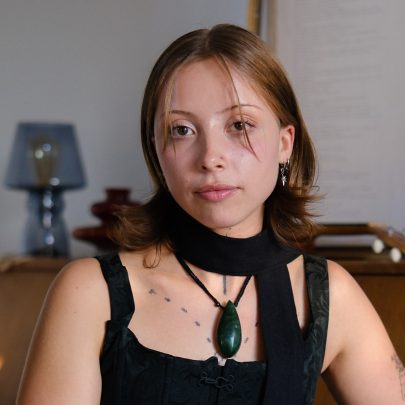May 17, 2014 Books
Elizabeth Knox has made a life’s work of dealing with impossibility.
To begin with an ending, here is one of my favourite punches to the solar plexus: the word “impossible.” It’s the final word of Elizabeth Knox’s breakthrough novel, The Vintner’s Luck. It’s a single-word sentence and a single-sentence paragraph, like this:
“Impossible.”
Knox is good at dealing in impossibility. Who would have predicted that one of this country’s best-loved novels would be about the relationship between a 19th-century French winemaker and a gay angel?
Another word I like is “spoiler”: one of the most useful recent additions to the critical vocabulary, and a succinct description of a common sin which I will attempt to avoid here. Statistically, it remains the case that you are more likely to have read The Vintner’s Luck than any other of Knox’s 13 published novels, but let’s assume you haven’t. You don’t need to know how she sets up her ending, or the heart-breaking weight she gets that last word to carry, to appreciate the structural elegance of it: an expansive story — heaven and hell, war and peace, a whole human lifespan — narrowing down to the smallest possible syntactic unit, like a pyramid balanced on its tip. Ending a novel well is a specific and underrated skill; I have only read one book from the past 20 years which ends as strongly as Vintner’s, and that’s Hilary Mantel’s Booker-winning Bring Up the Bodies.
Angels are a problem for a serious writer. They’re deeply embedded cultural cliches: how do you make them fresh? They’re objects of derision for some readers, and of sincere belief for others: where do you pitch your tone? And they’re human beings with wings, something neither biology nor the physics of flight would, in fact, allow. Here is Sobran, Knox’s winemaker hero, waking up out of the dead faint he fell into on first encountering the angel Xas:
He lay braced by a wing, pure sinew and bone under a cushion of feathers, complicated and accommodating against his side, hip, leg, the pinions split around his ankle. The angel was breathing steadily, and smelled of snow.
Xas is a vivid physical presence with a personality to match, as unanticipated and periodically baffling as any stranger you’ve ever fallen in love with. When I say that Knox is good at dealing in impossibility, this is what I mean. There is a high-res intensity to her writing, a characteristic just-out-of-the-furnace glow. Whether she’s writing about angels, islands that shuttle between dimensions, lethal universe-hopping parasites, or something as prosaic as a hot air balloon in the skies just north of Wellington, she burns right past cliche.
With the sun shining through it, the balloon was a Chinese lantern. Lex saw, briefly, a plume of pale flame, the heat against the sky rippling crumpled cellophane, and heard its full-throated, blow-torch roar. The balloon hitched higher and crossed the bay above her. She heard its basket creaking, heard voices (the host of the air), saw a distilled shadow, darker than a cloud’s — like nothing but the shadow of a balloon.
Lex is 10 years old, and she’s swimming in Browns Bay, in the Pauatahanui Inlet. Lex is also the young Elizabeth Knox, as translated into fiction for The High Jump, her autobiographical novel about growing up in and around Wellington in the late 60s and early 70s.
Look at the calculated density of the images Knox uses here. The back-lit balloon as a Chinese lantern. The alliteration of “plume” with “pale”, and the near-rhyme with “flame”. (Read “plume of pale flame” aloud.) The cellophane, the blow-torch roar, the rhythmic jerk of “hitched higher”, the parenthetical host of the air: this is how Lex, an intensely imaginative child, perceives the world, full of rich sensory cross-connections and bracketed tangential presences.
By the end of the paragraph it registers as strange that the balloon’s shadow should remind her of nothing at all except itself. Naked reality defamiliarised, voices on the air. This is what it’s like being inside Lex’s head. Lex’s adult self is Elizabeth Knox, and she lets us inside her head with every book she writes.
There is a howling abyss of pain underneath Wake, which was published late last year. The same pain feeds into Mortal Fire, published earlier last year and written over the same period. Wake is a horror novel, opening with a charnel-house sequence in which the occupants of a small town turn on themselves and die nightmare deaths, and then tracking the quieter but more disturbing experiences of the handful of survivors, who find themselves quarantined with hundreds of variously mutilated corpses and an invisible monster.
Mortal Fire is a young-adult fantasy about a man trapped in a tiny space by a curse, and a strong-minded teenage girl whose willingness to break rules makes her the ideal person to break curses.
In formal terms, both books are variations on the themes of grief, and loss, and confinement, but they require Knox to solve two very different sets of major and minor technical problems. As a demonstration of versatility, writing these novels back to back is a nice feat.
They are not a demonstration of versatility, of course. They’re the books Knox wrote during and after the years in which her mother was slowly being chained up inside her own body by motor neurone disease. I asked her once, well before her mother’s death, why she is driven to put so much of her own life into her work. She said this: “There’s that point where you realise that you’re finite, and the world is beautiful. And if both understandings hit you at the same time, you feel dread, and you feel awe and love, all at once. To preserve what you love against what you dread, you’ve got to write something.”
Elizabeth Knox is a guest of the Auckland Writers Festival, May 14-18. writersfestival.co.nz





